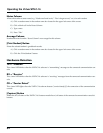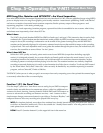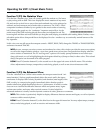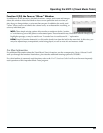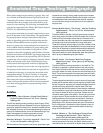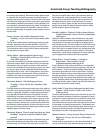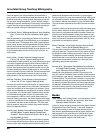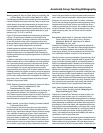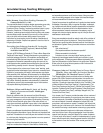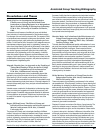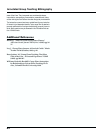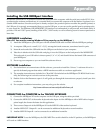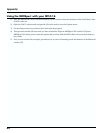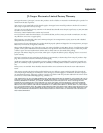
Dissertations and Theses
Diehl, Lily Pan. An Investigation of the Relative
Effectiveness of Group and Individual Piano
Instruction on Young Beginners in an Independent
Music Studio Utilizing an Electropiano Laboratory.
D.M.A. diss., University of Southern California,
1980.
This research study focuses on the effects of group and individual
piano instruction on musical achievement for piano students ranging
from the ages of six and a half to nine and a half. Five aspects of musi-
cal achievement were measured, including aural discrimination, knowl-
edge of musical symbols, public performance, sightreading and trans-
position. Out of these five skills, the results in four categories were con-
stant between private and group study. In sightreading, however, the
author found a significantly higher level of performance in the students
who received piano instruction in groups. Students of the age of eight
who studied in groups scored even higher than their private study
counterparts in the sightreading portion of the research. In addition,
males who studied in groups achieved a significant difference in the
category of public performance. This data may serve to direct the inde-
pendent teacher toward group instruction, with particular emphasis on
the development of sightreading skills.
Magrath, Dorothy Jane. An Approach to the Teaching of
Theory/Musicianship Classes for the Pre-College
Pianist as a Supplement to Private Instruction.
D.M. diss., Northwestern University, 1982.
Emphasis on developing basic musical understanding beyond that
required to play a given piano piece is the focus in this dissertation.
Spiral learning, in which concepts are transferred from the piece in
which they were first encountered to other works, is advocated through
classes supplementing private piano lessons. A thorough integration of
concepts encompassing style, theory, analysis and aural awareness is
recommended.
Valuable sources contained in this dissertation include learning objec-
tives, a curriculum and suggestions for teaching the previously men-
tioned concepts. Procedures and appropriate materials for attainment
of these objectives are proposed. Textbooks and workbooks that may
be useful to the teacher in a group setting are listed in one of the
appendices.
Rogers, William Forrest. The Effect of Group and
Individual Piano Instruction on Selected Aspects of
Musical Achievement. Ed.D. diss., Columbia
University, 1974.
The purpose of this study was to investigate the effects of different
modes of instruction on student achievement levels. Rogers measured
the students’ abilities in aural discrimination, knowledge of musical
symbols, sightreading, transposition and improvisation before and after
the period of study. Sixty-four students aged 7-9 participated in the
study, which took place in a school in Harlem, New York.
Results of the study indicated the group students tested higher in all
five areas of ability than their counterparts who had private instruction.
This may be attributed to several factors, including teacher training,
peer interaction, supervised practice and more instructional time for the
group piano students. Conclusions of the study focus on the greater
achievement levels of the group students; no measurable difference
was found in students of varying sex or age. An interesting point to
note is that participating teachers having experience in both group and
private methods unanimously favored group piano over the more tradi-
tional private instructional approach.
Shender, Marie. An Evaluation of the Effectiveness of a
Group Piano Program using Electronic Keyboard
and Computer Technology. Ed.D. diss, Columbia
Teachers College, 1998.
This study identifies the educational benefits and drawbacks of a sam-
ple group piano program through feedback from students, parents and
teachers associated with the program. Parents reported musical
growth through the program, and students expressed enjoyment of
group activities involving piano lessons, group songs and use of other
instruments. High motivation was cited as a benefit, while lack of indi-
vidualized attention was mentioned as a problem. Competition
between students was regarded as healthy because it encouraged stu-
dents to progress more quickly. Advantages and disadvantages of
group instruction are discussed, with recommendations given for stu-
dents, parents and teachers taking part in piano classes. Integration of
technology into the group piano classroom is cited as a benefit, and
exposure to musical software in the home is also linked to increased
musical growth by the student.
Skiba, Marlene. Foundations of Group Piano for the
Independent Teacher. M.A. thesis, Northeastern
Illinois University, 1988.
Three main aspects of group teaching are discussed in this scholarly
yet accessible work. Group dynamics, the history of group learning and
a methodology for developing an effective group program in the private
studio serve as the headings for the three sections. Chapters 1-3 focus
on understanding the cognitive process, behavioral patterns and ways
in which the group teacher can channel competitive and cooperative
personalities to provide a conducive learning environment for the stu-
dents. A great deal of historical background is included in this section.
The author deals with the task of explaining the role of the group and
the individual’s functions within an educational setting. Group cohe-
siveness is given careful consideration.
Chapters 4-6 contain an overview of the history of group learning. The
results of a statistical survey of members of the Illinois State Music
Teachers Association are given, and the interpretation of these results
is given at a later point in the thesis. A difference in the profiles of the
private and group teacher in the independent studio present points to
ponder. For instance, results indicate that group teachers tend to be
more schooled in the areas of psychology, child development, group
teaching and improvisation. They are more likely to have a teaching
studio outside of the home, and also may own more teaching aids than
the private teacher. Group teachers tend to be more innovative, more
achievement-oriented and more interested in group activities in all
Annotated Group Teaching Bibliography
41



